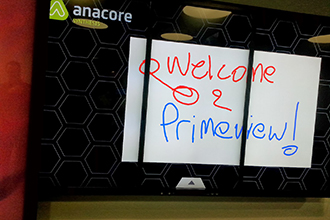
The space itself was a tiny three-room postage-stamp kind of place on the eighth floor of a conveniently located Midtown office building. The small space has a clean, semi-industrial look with an open ceiling (all painted black) and clean white walls on which, of course, a ton of video monitors hang for our perusal. A few of my impressions as I walked through the space:
All of the walls aside from the Sypder demo (the Haivision 2×2, the 1×3 portrait wall, the interactive 1×3 portrait) were run off of a TVOne Coriomaster video wall processor with HDBaseT output cards. HDBaseT receivers are a combination of Magenta Research and Primeview panels with integrated HDBaseT receivers. Two of these had “daisy-chain” capability with an HDBaseT output mirroring the HDBaseT input. This is a terrific solution for corridor signage, to give one example. Also nice for a demo room in which the same content is being mirrored on various displays. The Coriomaster is very flexible in being able to support portrait, landscape, and any orientation in between. It’s not the same as a Spyder (lacking, amongst other things, the front-panel buttons, some advanced features and flexibility, and a certain reputation for reliability), but still an interesting product.
After I chatted with some of the other technology parthers, Chanan Averbuch of Primeview treated me to the grand tour. One thing I appreciate about Primeview is the level of enthusiasm their team has about the company and the technology. They’re excited about plasma, excited about the quality and feature sets of their displays (4K. Integrated HDBaseT. Near-seamless bezel-free walls). He also took me through a nice demo of the Anacore collaborative software. It handles collaborative tasks (whiteboarding, annotation, etc) with a nice, slick interface which also allows very easy archiving and sharing of markups.
The final partner I met was Bouncepad – makers of nice custom-labelled iPad mounts. This is quickly becoming another crowded corner of the industry, but theirs did have a very nice, clean look.
Aside from the aforementioned partner demos, some things stood out to me:
2) Highlighting technology partners definitely makes it a different experience than a single-manufacturer room with displays would have given. At the risk of being buzz-wordy, this felt like a presentation of solutions as opposed to products.
2) The Anacore collaborative software running on the 1×3 wall in the front room is interesting. This is another section of the market with quite a few players, but it’s always interesting to see the strengths and weaknesses of a new solution. This kind of collaboration is certainly a wave of the future.
3) A fairly wide variety of monitors are displayed, including plasmas and LCDs. Did you notice the color being a bit different in one panel on the Haivision demo? That wasn’t my camera; the wall contains different LCD panels so you can compare the brighter version to the slightly less bright version with better color reproduction.
The room itself is very slightly a work in progress; the rack cabling can stand re-dressing, and some nearby construction knocked some of their video walls out of true. Once it’s readjusted just a bit, this will be a very interesting and nice demo area for us in the AV world here in New York.